To progress the previous JavaScript experiment further I was able to, with the help of James Field, animate the mouths to the frequencies from a microphone input rather than just a loaded sound file. This creates a more interactive effect whereby the animation reacts spontaneously to the sound in the environment. This also allows people to interact and use their voice in order to alter the animation and see the visual representations of their own voices. More work needs to be done however as after it has run a while the animation begins to lag and the reaction of the mouths slows down, in a live setting this wouldn’t be effective and I will look into a way to get around this.
Author Archives: Louise Catherine Lawlor
Synthetic Voice Experiment 1
Following on from my initial concepts of the creation of devices/ prosthetics to extend the voice beyond sound and beyond the body I conducted an experiment of the first visual aspects I had whilst reading Brandon LaBelle’s writing on the mouth. Taking this as a movement from the depths of the body to the surface of the skin in an action of stretching, I transformed this into physical bands that replace the biological structures of the mouth. The bands work to take the voice from inside the body into the outside environment and back again. This on first view has a horrific and invasive effect, working to highlight the intensity of the voice on the body and show those intensities we do not notice. Taking this further I took inspiration from Shaviro’s writing on sentience and the idea that instead of waiting for a stimulus in order to produce action, sentient beings reach out into the environment to probe it with spontaneous actions to then evaluate the sensory feedback. From this I explored how cephalopods use a tentacle device to explore their environment, initially these experiments are spontaneous reactions to these concepts and utilise both a transformed idea of an artery/ biological messaging tool to take the voice through the body and out to the environment and a tentacle device that can reach out and explore. Both these again have a comfortable effect and, when combined with textures you wouldn’t expect, begin to expand the human beyond the limits of the body and in turn expand the voice beyond sound. Texturing here consisted of giving the synthetics a glossy finish with colours grounded in the biological, but subverted through the shiny plasticity of the finish. Further experimentation needs to be done here to move away from the clear biological structuring of the face and the merging of it with the synthetic mouth.
This experiment also allowed me to explore aspects of blender which were new to me, for the tentacles I used an armature that when combined with a bezier curve allowed me to manipulate the shape and positioning of it. This worked to bring in the fleshy, viscous aspects of the synthetics as derived from the mouth.
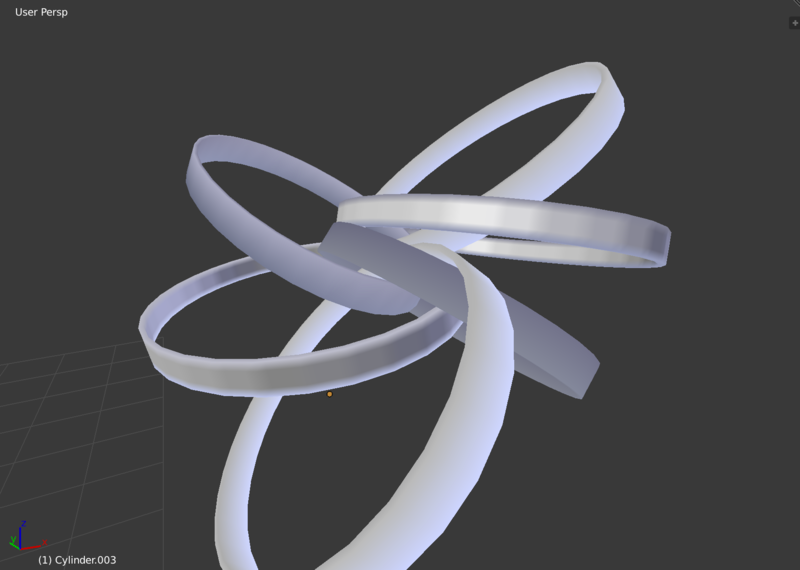
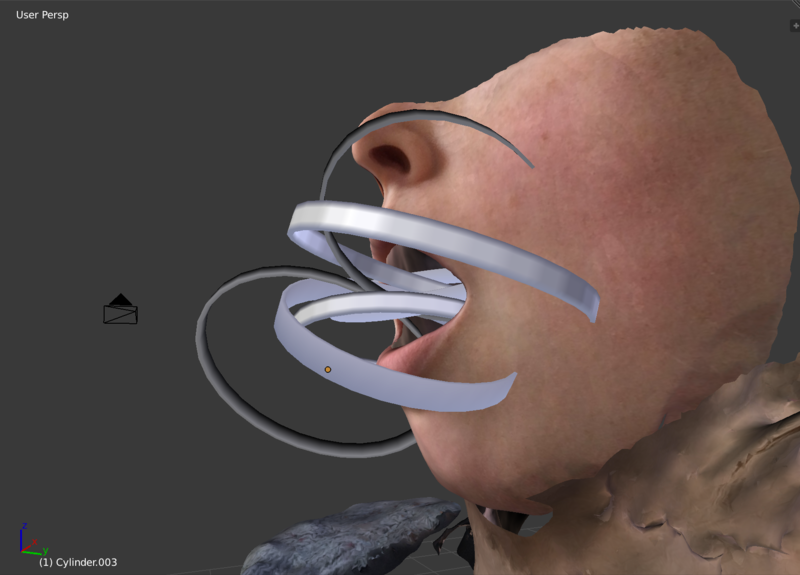
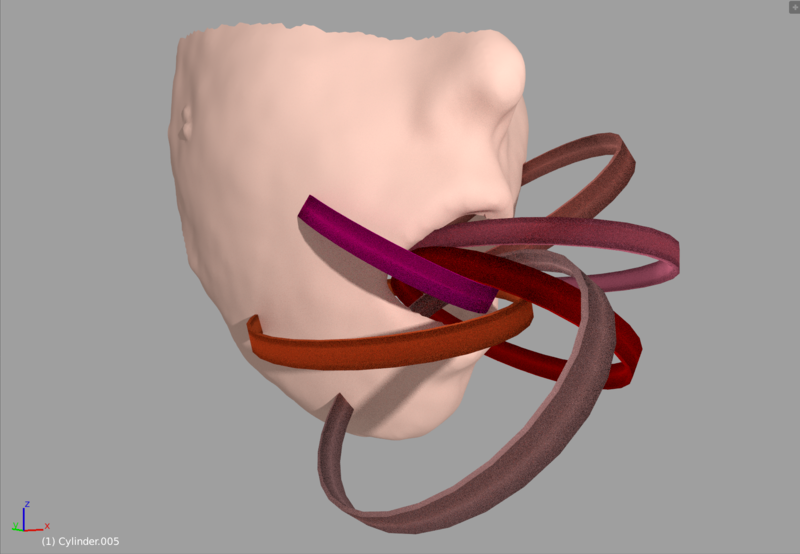
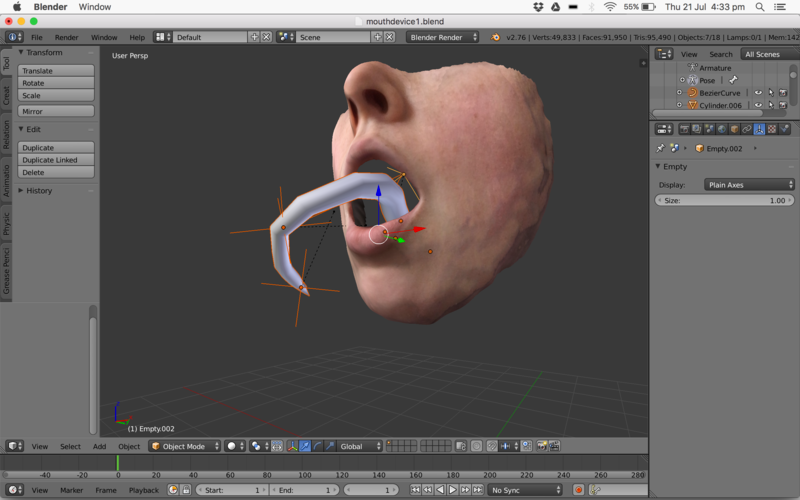
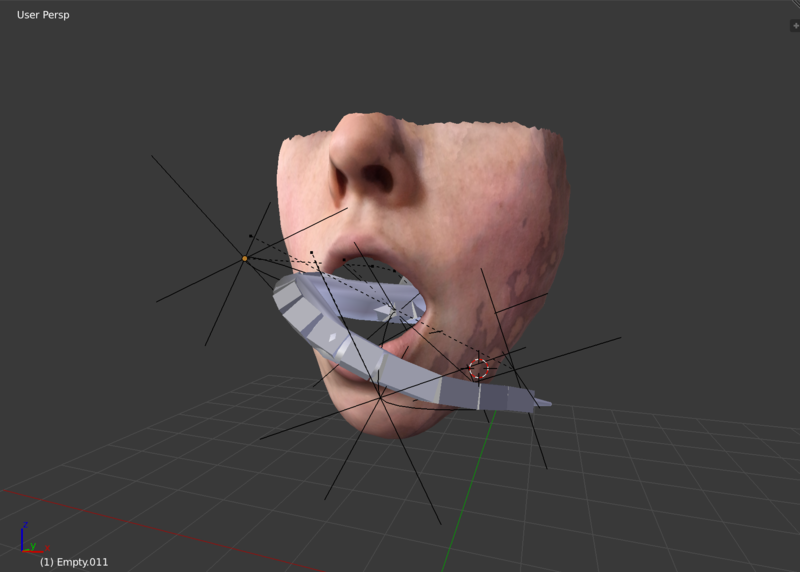
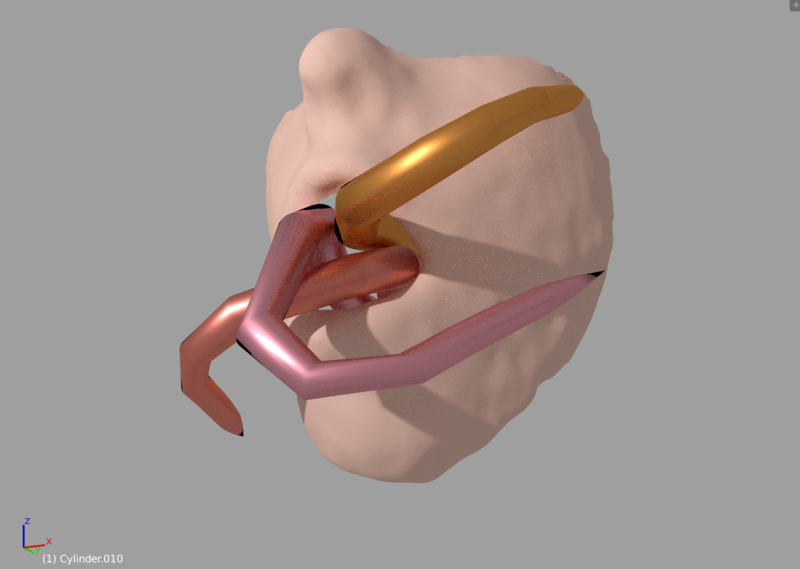
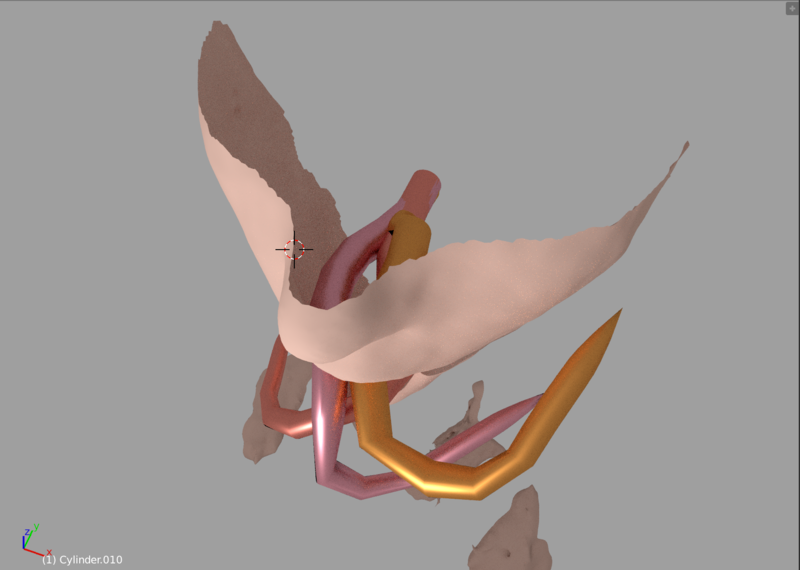
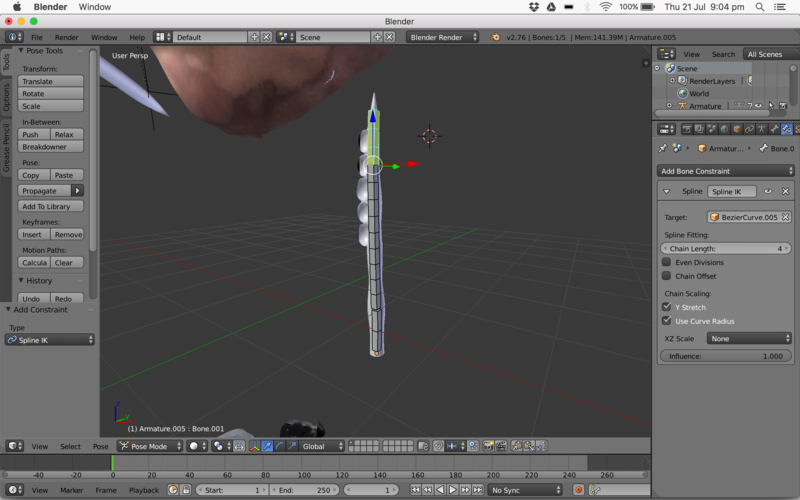
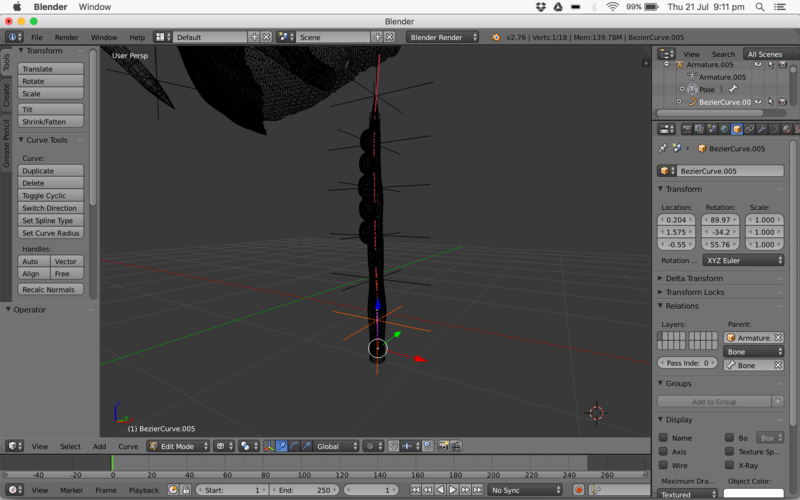
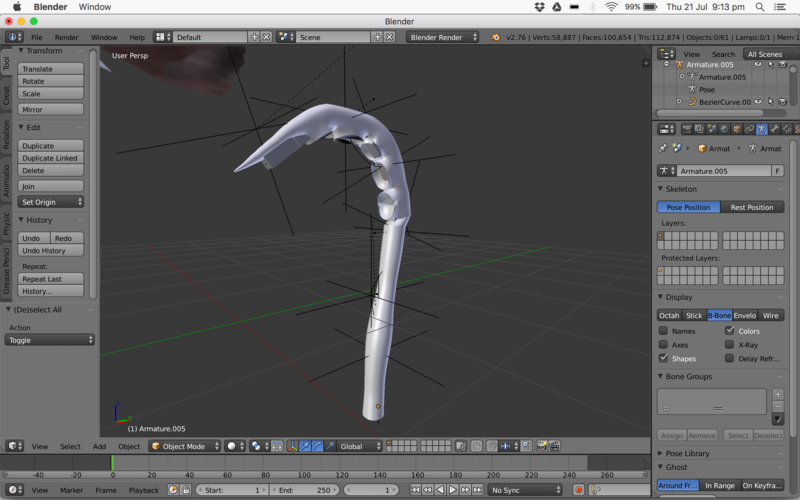

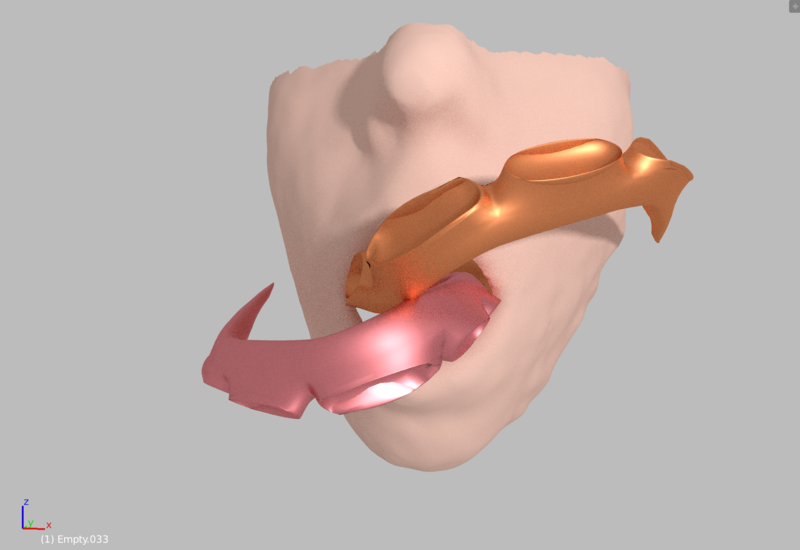
Resin Cast Experiment
After my experiment to make a silicone mould from a 3D printed version of the teeth I then made a series of casts using polyurethane resin. This was a simple process using two parts mixed in equal measure poured into the mould and then left to cure for an hour, the resin naturally has a pale fleshy colour that gave an interesting effect to the final casts. These appear soft and malleable but in actual fact are hard and sharp. Each one has its own mistakes or differences where the resin has cured slightly differently or went over the edge of the mould, this shows the notion of making copies and each being imperfect to the next. Each time a copy is made a different set of teeth is achieved, in this way they are no longer just a copy of the original 3D print they are originals in themselves.
The next step in this experiment is to test the inclusion of a pigment to alter the colour of the resin, for this I have tangerine orange polyurethane pigment. It will be interesting to test the how the different amounts of pigment affect the colour and if it is possible to achieve a marbled effect.







JavaScript – Audio Frequency Animation
In order to develop my experiments with JavaScript animation in Project 2, I have extended this for the interaction be based not just on an audio input but on the frequency of that audio input. This gives a more nuanced reaction and a greater scope for animation interaction, the frequency can be broken up and elements isolated to only react to a certain range of these. Initially (with the help of James Field) I have been able to set this up to have three mouths reacting by rotating to a degree specified by the low, mid-range and high frequencies of a loaded in audio track.
The next step is to have this react to microphone input, again pulling out the different range of frequencies for the .obj file to react to.
Prosthetic Voice – Initial Concepts
Breaking the notion of the creation of devices/ prosthetics to extend the voice beyond sound down into layers of biology that can then be built up again through the synthetic. Thinking of this in terms of three structures; the face, the torso and the hand, and then breaking this down further into hard, soft and muscle aspects. Each layer can be focused upon and then brought together in collaboration and a merging between these synthetic devices and the human body.
Initially these concepts focus on the face, exploring from Brandon LaBelle’s writing the philosophical concept of the voice and in turn the mouth.




Prosthetic Voice
As part of the explorations to create a prosthetic device that extends the human and questions how the human voice can communicate without sound, the following aspects needs to be considered as taken from Brandon LeBelle’s Lexicon of the Mouth:
- Movement
- Depth of the body > surface of the skin
- Forces outwards – stretches (cord like)
- Resonating cavity – echoes with vibrations
- Sustains
- Suspends
- Environment leaves deep depressions on the voice – on the surface of the tongue
- Path through the body
- Series of surfaces
- Figures
- Disfigures
- Weave of surfaces – modular in structure
- Body textured
- Emotion
- Sexuality
- Longing
- Intellect
- Language
- A facility
- An animale production
- A gesture
- Bending/ Flexing/ silencing/ exaggerating
- Fluid/ stream/ swarm
- An operation
- An instrument
- Dynamic state
- Doesn’t maintain a strict stable presence
- Elasticity
- MOUTH
- Wet impressionable envelope
- Ingestion
- Incorporation
- Emanation
- Expulsion
- Attachment
- Loss
- Series of knowledge paths defined by its orifice
- Viscous – captures
- Cutting and augmenting
- Shapes
Silicone Mould Experiment
As an experiment into the use of materials I decided to continue with the notion of plasticity I have been exploring to date, not only in the material sense of using actual plastics but also the idea of the plasticity of the body whereby it has the power to both give and receive form. From this one of the plastics that fit was Silicone, a material that has an elasticity and a power to be cured into different shapes whilst retaining the ability to be flexible even when solid. As an initial experiment in testing the limits of this I produced a mould using a set of the 3D printed teeth as the source object that can later have copies cast using various other plastics. The process was relatively straightforward, the teeth were positioned in a plastic container and any areas filled in as necessary with modelling clay. The silicone rubber was then mixed with a catalyst in order to allow it to cure into its solid(ish) state, then it was poured over the teeth and left for 24 hours. The releasing of the teeth was the most difficult part, trying to prise the silicone away from the detail sections between the teeth need some help with a scalpel. This has left a rougher finish than I was hoping for but the impressions of the process to create it may give some interesting effects when a copy is cast.
The next step is to produce the cast copy, for this I have polyurethane resin and an orange pigment.




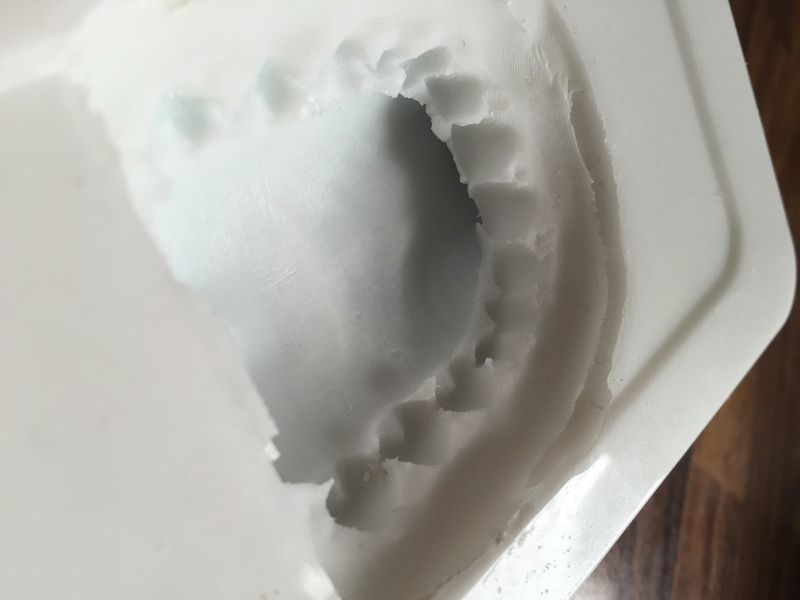
Research – Body Hacking
Exploring the notion of synthetic/ artificial prosthetics further I watched the documentary Bodyhack: Metal Gear Man, this goes through the story of James Young who answered a call put out by Konami (makes of Metal Gear Solid) to take part in an experiment to create a bionic arm as a marketing campaign for the game. The documentary itself focuses more on James’ story than on the actual journey and any underlining views of experimental prosthetics. The more interesting parts come when we actually do see the machinic arm, in all its non-working glory. From this the notion of body hacking and the merging of the body with technology stood out for me, some (well most) of this still feels extremely gimmicky but there are parts of the documentary that make useful comments on the phenomena. Particularly when prostheses don’t work and the initial arm that is produced is cumbersome and heavy, easily breakable and having the sense of an afterthought add on to the human body. Rather than being something that is merged with and working in collaboration, when the prosthetic malfunctions it appears alien and evokes a feeling of otherness in his own body.
This idea of body hacking in relation to the idea of prosthetics and the extension of the human through that which is artificial has some interesting application in art practice. One of the most notable of these is Stelarc who has experimented in various ways of extending the human body beyond its limits. The implanting of an ear into his arm is one of the most interesting through the use of re-contextualising the biological make-up of the human, he has since experimented with implanting a microphone and the possibility of making it wi-fi enabled. Again while the pushing of the body beyond it’s biological limits, this is still very much grounded in its biological make-up. Although as a device that utilises the processes of the body merged with the machinic results in something that forms a fused connection. You being to lose where the organic ends and the machine begins, which transports you into the realm of the cyborg.
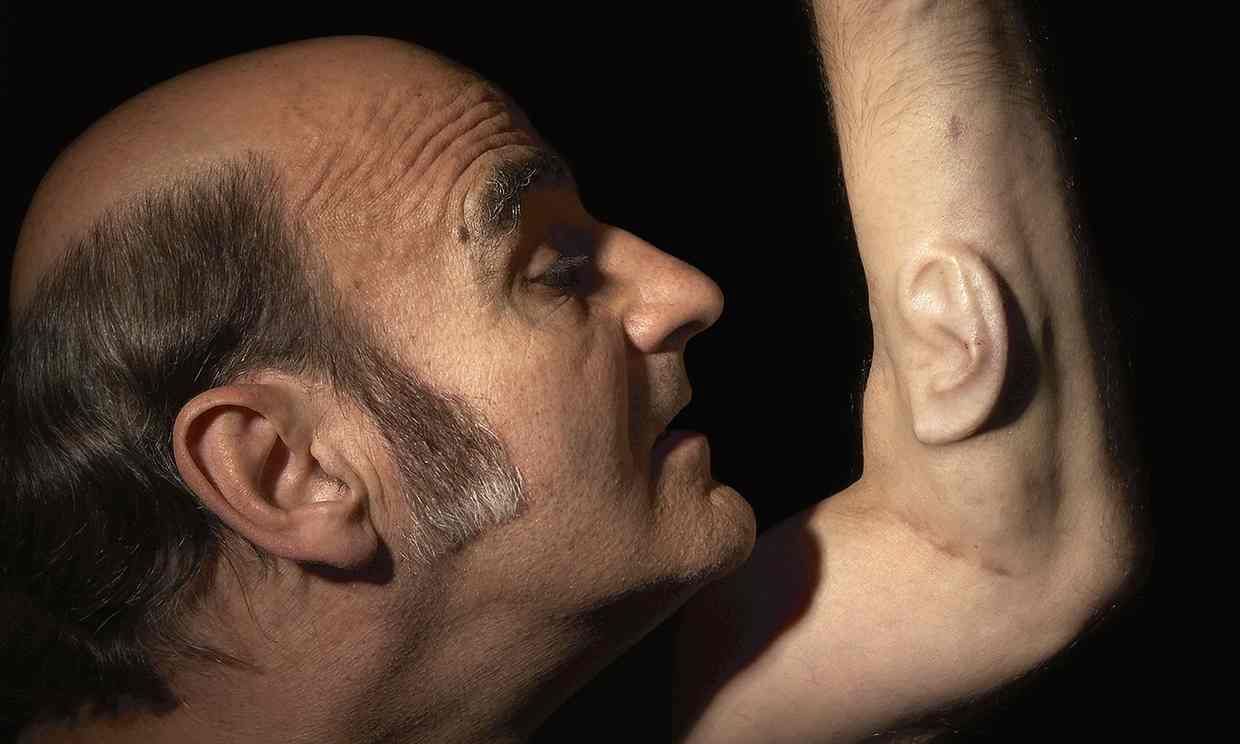
Along a different line of thought but still utilising bodily processes in order to extend it, Naomi Kithner’s project Energy Addicts explored the production of devices that harvests the human bodies’ energy and converting this into power. The objects themselves while beautiful and jewellery like, have a harsh reality to them in the invasive nature they are implanted into the skin. The need to be inserted by the user directly into he skin in various places depending on the area of the body you want to harness plays on the idea of medical needles and the horror of body modification. The use of a device that puts the body on intimate terms with the synthetic whilst simultaneously extending it to be of use is very interesting to consider in connection with my project. Would it be possible to create devices that can allow the human voice to communicate without the use of sound? Could the mouth be extended to utilise the process of the voice and transform this into a commodifiable thing?
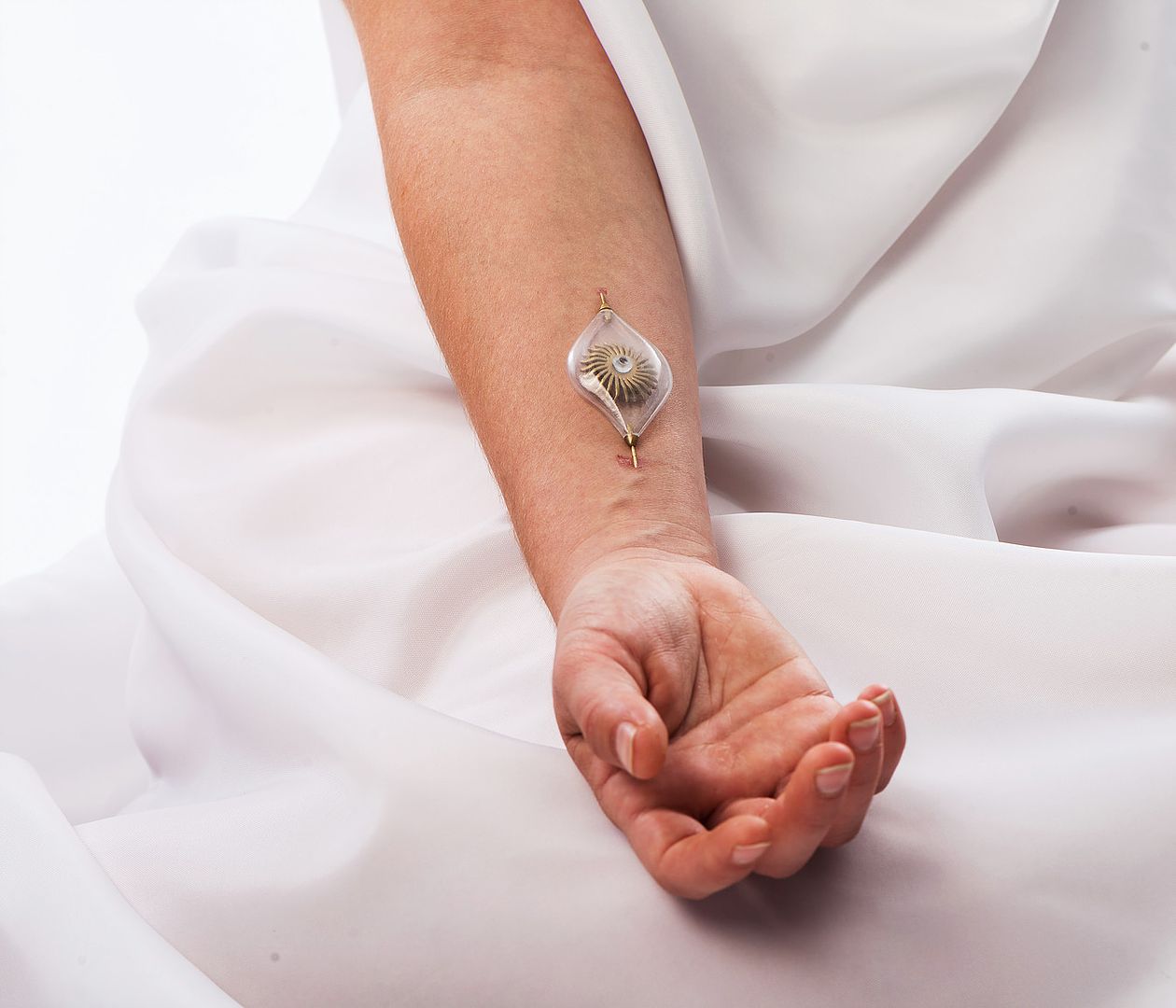
Research – Synthetic Function
Taking forward this idea of the transformation of the synthetic human, whereby the prosthetic elements have a developed functionality that can either be positive or detrimental. I researched into the expansion of biology through engineering and came across an article on Motherboard called ‘A Bioethicist Argues for Engineering Babies That Will Have an Easy Life‘ by Richard Wordsworth. This centres around an argument by Professor of Practical Ethics Julien Savulescu that parents should be allowed to undertake a process of ‘procreative beneficence’, which essentially is the idea in reproductive ethics that asks the question what can we do to ensure each child has the best chance in life? In doing so parents would be able to select the genetic traits that would ensure this, i.e. intelligence, gender, level of impulse control. The article quite rightly returns the question what would happen to diversity? Within the content of the article interesting ideas are brought up that can be related to my project themes, particularly the engineering of the human in order to improve it. Along this line the article brings up the idea of the ‘inhumanity of posthumanity’ and the fact this process of procreative beneficence could create humans that only exist as emotionless drones and decent into a series of doppelgängers. This level of inhumanity is interesting to explore and to confront people with this in order to make them consider the ethics of our continued merging with both the machinic and the synthetic. Also the idea of the doppelgänger fits into the form of my project, with the synthetic human I have been creating so far derived from myself. Perhaps the project could then centre around the engineering of the self?
When applied in an art context the ideas above can produce very contrasting results, one example of this I found particularly interesting in their exploration and realisation of this is Ohlsson/ Dit-Cilinn’s exhibition Tadpole at Cinnamon gallery in Rotterdam. Here the artists explore the synthetic body as being a continuation of nature and not separate, through this they showcase the human body evolution as a space for the potential of transformation and the metamorphosis of self-realisation. The objects themselves, here called sculptures in the classical sense, are essentially existing objects that have been re-built and re-arranged in such a way that they have lost their original function. The objects take on a transformed function that exists more in the realm of biology and the living, showing a confrontation of the flesh with the artificial materials used to create the objects. One of the notions that stood out for me was the discussion of metanarratives that underpin their work, here they take the idea of transcendence of the mind by means of mediation and confront it with the separation of the body by means of the skin. The objects themselves have a vacuum like quality to them, appearing as if suspended in the transformation process. However I don’t feel they go far enough and at times appear more like tools that have been given a biological function, rather than biological functioning that has been transformed into tools.
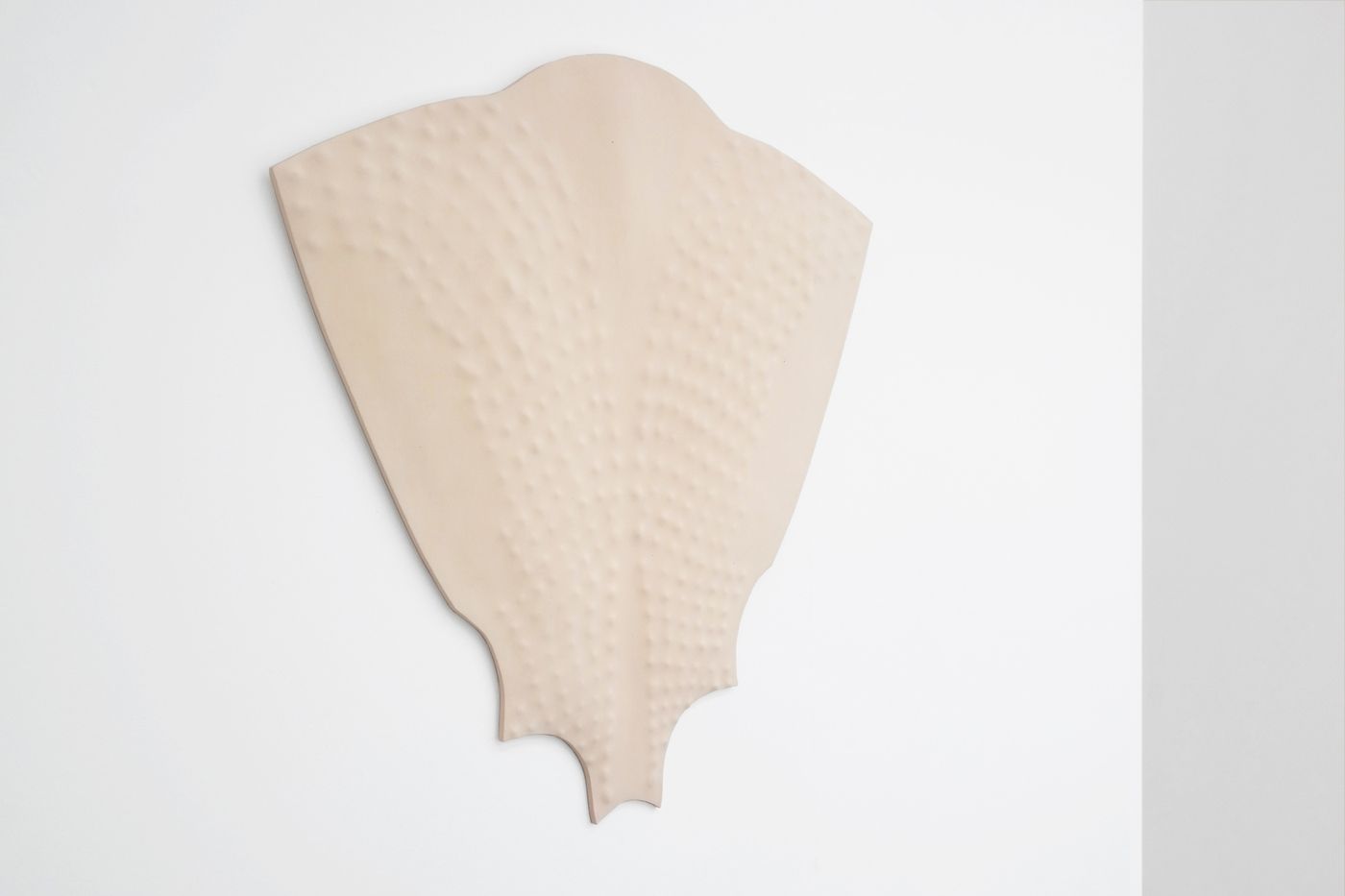
Again along a similar line of enquiry Bjork’s continued exploration of new technology in combination with her music has produced an experiment in multi-material 3D printing in collaboration with artist Neri Oxman. Here Bjork and Oxman have created Rottlace, its name derived from the Icelandic for skinless. This is a mask that has been designed to reflect the complex human musculoskeletal system based on Bjork’s own facial structure. The production of the mask has such utilised a development in 3D printing that allows you to print different materials at once, this as such allowed Bjork and Oxman to mimic the contrasting materials of the face including soft tissue, muscle and rigid bone to create a synthetic whole without parts. Not only does the mask work on an aesthetic level to produce a sense of otherness that comes with the synthetic, but it exposes and employs a process of the complex layering of structures that would be found in the human biological make-up. These layers are then fused together and work in collaboration to give form to something entirely different. The human here is extended beyond itself with the merging together with the synthetic, where the human is still rooted in the biology that formed it but goes further to enhance its limited capabilities. Ultimately the mask may be useless, but this transformation of function at least opens up the discussion on the topic.

Thoughts
Meeting with Graham Cooper 07/07/2016
- To consider the artificial elements of the human – do they need to have a formal structure?
- Could they be designed for a purpose?
- In the synthetic realm would this purpose be different?
- Notion of non-functional prosthetics
- The face and shoulders etc. could form a mask than can be worn – a form of synthetic exoskeleton
- Communication
- How does the human communicate without the sound of the voice?
- Isolated elements of the human – centred around the theme of communication (extend from the face)
- Use of myself as subject – connect with the theme of the project and make it personal in some way
- Function
- Construct in a different way
- Improve?
- Make worse? – dysfunctioning body or dysfunctional machinic communication?
- Turing test – artificial conversations
- The project needs to say something or speak to people
- Consideration of what it means
- Does it aid the world?
- Does it make people think about the world?
- Is it accessible?
- Does it work in multiple ways – multifunctional engagement?
